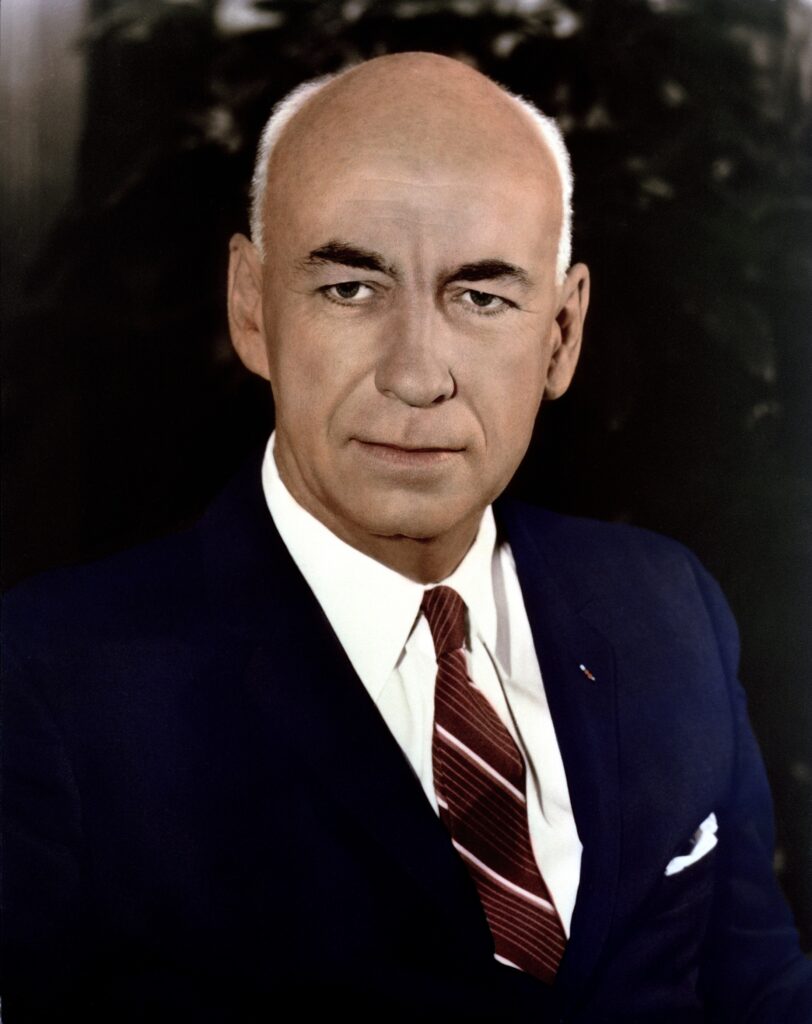The first Director of the Manned Spacecraft Center, now the Johnson Space Center.
Robert Gilruth was born in Nashwauk, Minnesota on October 8, 1913. His father and mother were both teachers but when Robert was eleven his father lost his job and the family had to move to Duluth, Minnesota. Although not an exceptional student Robert excelled at building model airplanes and even invented a feathered propeller for one of the rubber-band gliders he designed. He graduated from high school in Duluth then earned Bachelor’s and Master’s degrees in Aeronautical Engineering from the University of Minnesota in 1935 and 1936, respectively.
In 1937, Gilruth began his career in flight research for the National Advisory Committee for Aeronautics (NACA) at the Langley Memorial Aeronautical Laboratory in Hampton, Virginia. Here he earned renown in determining the handling qualities of airplanes during World War II. In 1945, he directed free-flight experiments for the U.S. military using rocket-powered models at Wallops Island, Virginia, investigating flight dynamics at transonic and supersonic speeds. In 1952, Gilruth was named Assistant Director of Langley, conducting research into hypersonic aerodynamics, high-temperature structures, and dynamic loads. Soon he was in charge of Langley’s pilot-less aircraft research division, which supported the research of a range of military and civilian manned rocket research projects, including the X-15 and Dyna-Soar.
When the NACA was transformed into the National Aeronautics and Space Administration (NASA) in 1958, Robert Gilruth became head of its Space Task Group, tasked with putting a man into space before the Soviet Union. When the USSR won that race with Yuri Gagarin’s flight in 1961, Gilruth suggested to President John F. Kennedy that the United States should announce a bigger goal, such as sending a man to the Moon. In 1962, Robert Gilruth was made the head of the NASA facility which ran the newly created Apollo program, the Manned Spacecraft Center (MSC), now the Johnson Space Center, in Houston, Texas. He served as director of the MSC until 1972 and oversaw a total of 25 manned spaceflights, from the suborbital Mercury-Redstone 3 flight in May 1961, to the Apollo 15 lunar landing mission in July 1971.
Robert Gilruth retired from NASA in 1973. In his career he had been honored with the highest awards given by the aerospace industry and academia, including the Sylvanus Albert Reed Award from the Institute of Aerospace Sciences, the Daniel and Florence Guggenheim International Astronautics Award of the International Academy of Astronautics, American Society of Mechanical Engineers Award, the City of New York Medal of Honor, Spirit of St. Louis Medal by the American Society of Engineers, several NASA Distinguished Service Medals and the President’s Award for Distinguished Federal Service.
Gilruth also received the prestigious Goddard Memorial Trophy of the National Rocket Club, the Louis W. Hill Space Transportation Award, the Reed Aeronautics Award and the National Aeronautical Association and National Aviation Club’s Robert J. Collier Trophy for “. . . the greatest achievement in aeronautics and astronautics in America.”
Robert Gilruth died in Virginia, on August 17, 2000, at the age of eighty-six. His coworkers paid tribute to his accomplishments. “A lot of people thought going to the moon was impossible,” said Apollo 12 and Skylab astronaut Alan Bean. “People like Gilruth made it come true. I think of Wernher von Braun as building the rockets and Dr. Gilruth as getting the spacecraft ready.”
“He was one of the greatest men I worked for and with,” said Dr. Christopher C. Kraft Jr., who succeeded Gilruth as Johnson Space Center director. “He was the father of spaceflight and certainly never got the credit he deserved.”

